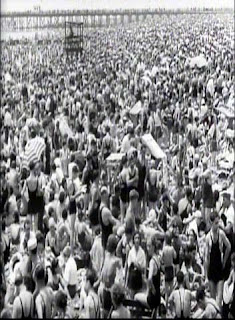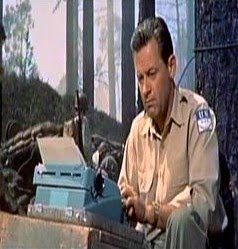
For the next two posts, we’re going to tackle two films with a few elements in common, but how much of this is due to coincidence and how much due to the prevailing social winds of the late 1950s, I leave you to decide.

That they both include pivotal, and very entertaining scenes at community Labor Day picnics is certainly a coincidence (which both showcase dueling barbershop quartets), but there’s a lot more going on than picnics, and the community at large is an ever-present, one might suggest omnipresent, force in the stories of these two films.
 We’re marking Labor Day and small-town life through the films “Peyton Place” (1957), and “Picnic” (1955).
We’re marking Labor Day and small-town life through the films “Peyton Place” (1957), and “Picnic” (1955).Both are set in small towns. Both involve a soap-opera style telling, tiered interwoven stories of different generations of characters. Sexual awakenings. Middle-aged yearnings. Small-town prejudices and stifling judgment. A fear of scandal. Even labor versus management issues. The rich town scions, and the people struggling from the houses by the railroad tracks. For some characters, a need to fit in to the small town life, a desire to remain sheltered by it. For others, a need to escape to a broader, more diverse, more challenging world.

One represents a New England mill town, and the other an agriculturally-based town in the Midwest. They are like fraternal twins. Both films are heavy on location shooting and give us a great sense of place. We know where we are. We see the outside, the tangible very well, the solid pictures of American Main Street and back yards. These films try to give us a picture of their inner turmoil as well, but that is intangible and tricky to photograph.

And both films, coincidentally, feature Betty Field as the careworn mother of troubled teenaged daughters. She is the Midwestern abandoned wife and mother seeking upward mobility for her daughter through marriage. She is New England drudge, the wife of the town drunk, who suffers agonies over his brutality, and even more over the horror of what people will think. In both movies, she is the victim both of her husband and her own apathy. In both movies, living by the railroad tracks signifies her place in her rigid society.

Was there really such universality in America in the 1950s, such homogenous experiences? Or did we unwittingly create that all-purpose template just to tell the story, which has now become textbook 1950s Americana?

Both films originated from dynamic non-film worlds, “Picnic” from the Broadway stage, and “Peyton Place” from a blockbuster novel. Film changed them, because film uses its own language and puts its own spin on stories. Film also has, or did have at one time, a sometimes unspoken, and sometimes shouted out loud, requirement to not offend the public.
 I don’t believe either of these films could be made today, not simply because each in its own way is somewhat dated, but mainly because of what offended the public then and what does not offend it now. The power that lies in these two films is the way they consciously reflected their era, and also held a questioning mirror up to it. They flirted somewhat coyly with questioning what was accepted as appropriate.
I don’t believe either of these films could be made today, not simply because each in its own way is somewhat dated, but mainly because of what offended the public then and what does not offend it now. The power that lies in these two films is the way they consciously reflected their era, and also held a questioning mirror up to it. They flirted somewhat coyly with questioning what was accepted as appropriate.We commonly hear the term “PC” today and sometimes bristle that the constraints of being “politically correct” are hypocritical and oppressive. However, back in the supposed comfortable world of 1950s America, when men were men, women were women, homosexuals were whispered about, and racial minorities were mostly invisible (being invisible perhaps a knee-jerk remedy to offset the outright stereotyping in films of previous decades), there was a far greater and insidious tippy-toeing effort not to challenge the mores of society that makes any effort at being “PC” today pale in comparison.
Defying this conformity carried heavier punishment, and its governance occasionally bordered on persecution. Not rocking the boat socially or politically, or by prevailing standards, morally, was the oppressive guiding rule, the obsessive-compulsive guideline of screenwriters, directors, producers, distributors, theater managers, and the public they provided entertainment to, from the Congressmen down to the paperboy. Any toe over the line could ruin the actor’s career, get the director fired, the ad campaign pulled, the threat of legal action for the studio, or even jail for the screenwriter.

Perhaps that’s why these two films were so entertaining, and enlightening for their day, and why they remain entertaining if only for their nostalgic value. They were films about small towns and regular folks that visually showed what was pretty and idyllic, and through the script showed what was repressive and ugly.
They may not seem terribly daring today, but they were filmed when it was okay to be a little seamy in movies about gangsters and criminals. But not about Main Street. As cleaned up as these films are not to offend too much, they still dared to suggest not everybody was happy.
One of the dangers the characters face in both films is public scandal, what the neighbors will think. Today, conversely, we may not even know our neighbors very well, let alone care what they think.
At least when it comes to social propriety. One may still feel the brunt of the neighbors’ ostracism, vandalism, or even physical threat if one disagrees with the neighbors’ politics. Social bullying, such as see with “town hall” thugs carrying weapons which they imagine give credence to their opinions, has gone far beyond whispering about the neighbor girl and what she does in the woods with the neighbor boy.
 These two films, in some ways much more than even some of the classic films of the 1930s, are very topical for their era. For all their supposed universality in depicting small-town America, they really are locked in that time, like souvenirs in a scrapbook.
These two films, in some ways much more than even some of the classic films of the 1930s, are very topical for their era. For all their supposed universality in depicting small-town America, they really are locked in that time, like souvenirs in a scrapbook. They are also, to some extent, fabrications.
They had meaning and influence on the society they reflected at the time, but we might wonder, did these towns, this America, ever really exist?
With Labor Day just around the corner, celebrate with “Peyton Place” and “Picnic” this Thursday and next Monday.

























